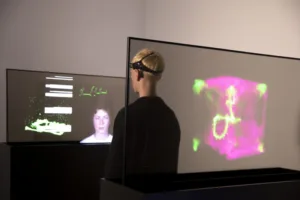LG Display, the world’s leading innovator of display technologies, announced that it teamed up with world-renowned Royal College of Art (RCA), London, to host the ‘Luminous’ art exhibition based on OLED technology at the Old Street Gallery in London.
Through its collaboration with the RCA, the world’s leading art and design university, LG Display plans to foster future experts in the media arts space and highlight the premium values of OLED as an optimal art canvas to further solidify its leadership in the market and introduce new and innovative solutions that defy convention.
Back in July, LG Display and the RCA kicked off its joint project ‘Luminous’, a 12-week art and design competition program named after OLED technology’s self-emissive nature. In this project, 52 students studying Information Experience Design at the RCA utilized various forms of the latest OLED technology including Transparent and Curved OLED displays to produce a total of 15 independent projects and 21 group projects with the purpose of “generating transformative experience of information that challenges or disrupts perspective”.
Based on self-emissive pixels, the OLED display has become a popular digital art medium that delivers true picture quality without distortion, loss, or exaggeration. To ensure the highest quality that does not compromise an artist’s original intentions, LG Display engineers provided technical and product support for the RCA students from the beginning stages of the competition up until the exhibition.
Of the five finalists selected from the ‘Luminous’ project to be displayed at the exhibition, three were group projects, which includes ‘Time-flux’, a four-layer Transparent OLED with spatial sound installation that creates visual and sonic experience of perceptual time in the form of flux, ‘A Room with a View’, which depicts two OLED display as a window that shifts between a realistic view and a hyperreal view, and ‘Invisible Reinvention’, which uses four curved OLED displays to emphasize OLED’s precise picture quality by depicting the movements and changes of micro-organisms in microscopic view.
The two independent projects selected as finalists include ‘ALPHA[BETA]’, a speculative system that visually represents post-language communication using transparent technology, and ‘Behaviours’, which features three OLED displays to create a moving image piece detailing the interactivity between charcoal, paper and sound.
Danielle Barrios-O’Neil, Royal College of Art’s Head of Program, Information Experience Design, said “It’s been exciting to watch our students push the boundaries of experience design during this competition. LG Display’s technology has made it possible to compose in unique ways with light and sound, and the result has been some startlingly beautiful, perspective-shifting work. I’m incredibly proud of what they have achieved.”
At the end of the exhibition, three winners will be selected out of the five artworks by a panel. LG Display will give winners an exclusive tour of its facilities in Korea later this year, where they will be able to experience the hub of OLED technology in person and receive inspiration from how the ‘digital canvas’ for many renowned artists is made.
LG Display’s OLED is already widely recognized by the art world for the unbridled creativity it inspires through its ability to deliver precise image quality and rich colors. The company has an expansive portfolio of collaborations with museums such as the Guggenheim and Smithsonian and brands like BULGARI to world-renowned digital artists like Refik Anadol.
“Collaborating with the world’s most prestigious art and design school, RCA, represents once again that OLED is the most optimal art canvas,” said Jin Min-kyu, Head of Life Display Promotion Division at LG Display. “In addition to working with various fields of art based on our next-generation OLED technology, we will continue to promote premium values of OLED through its unsurpassed image quality and various design factors that allow for endless applications.”

